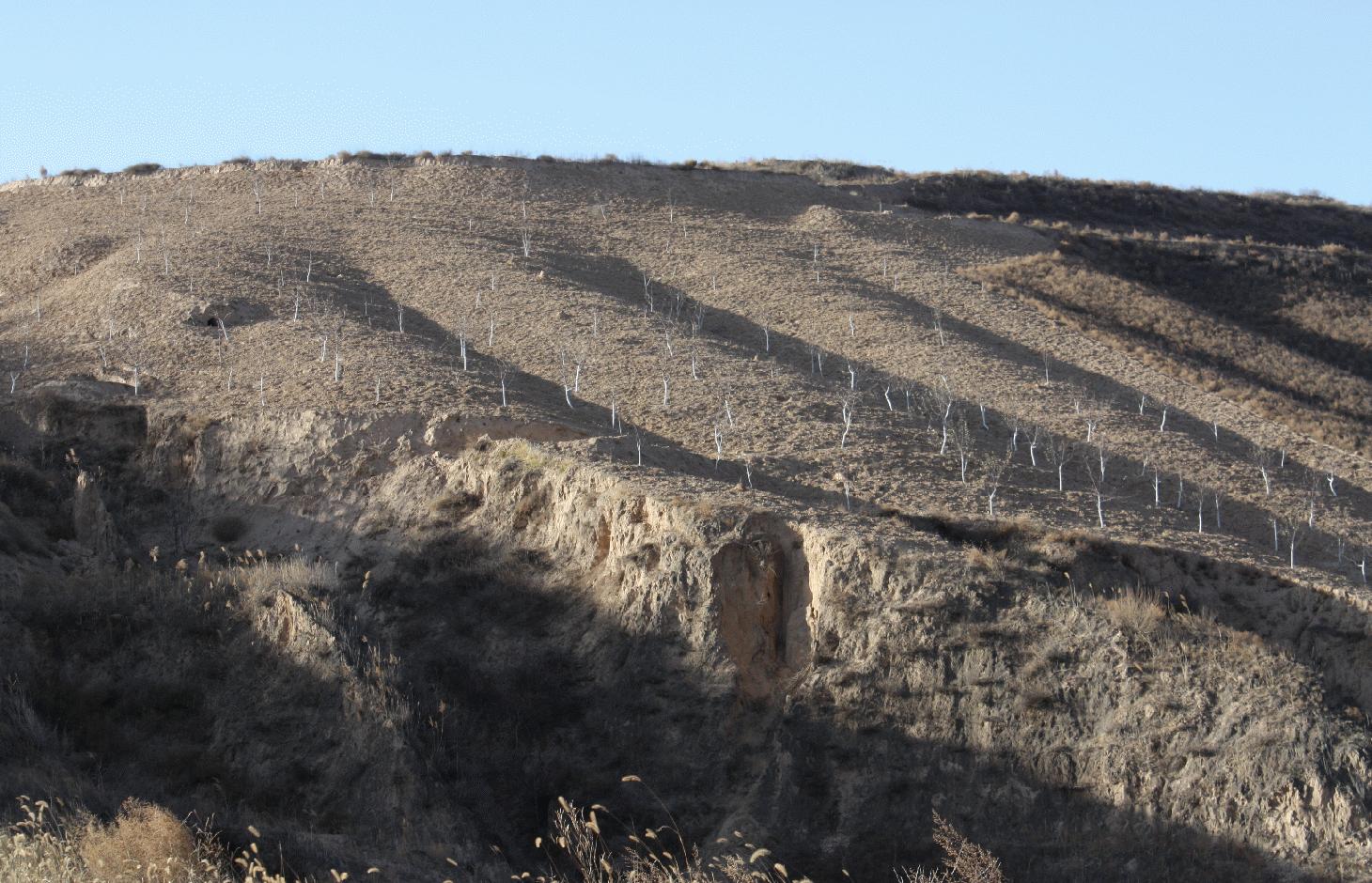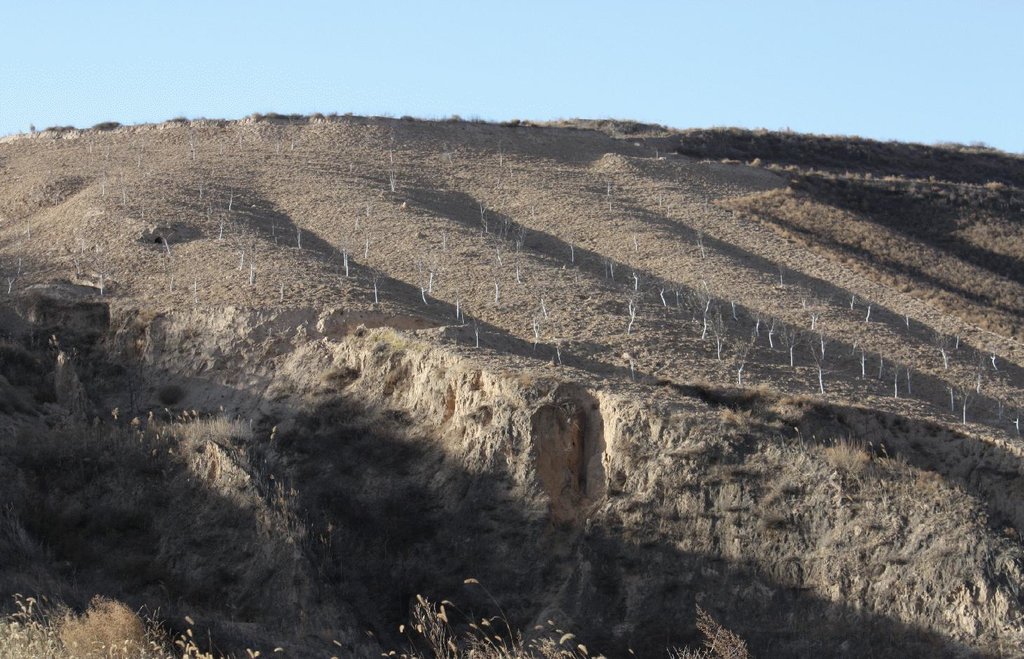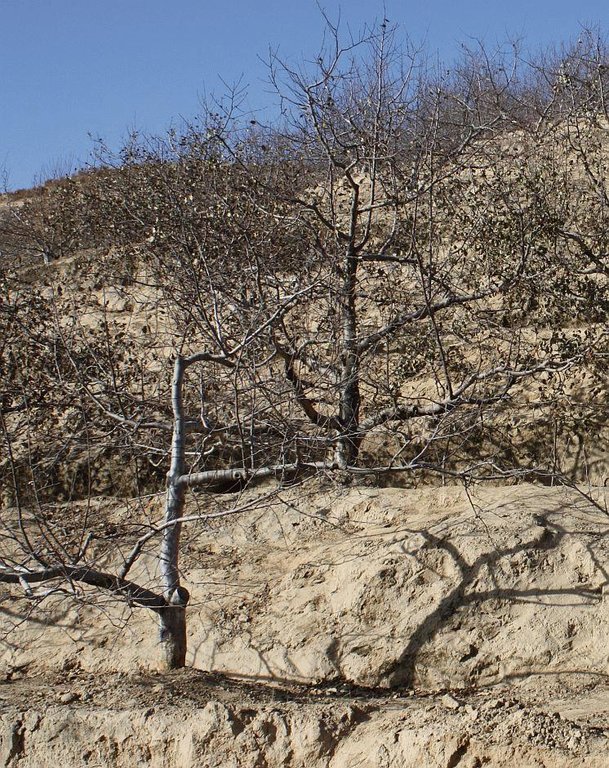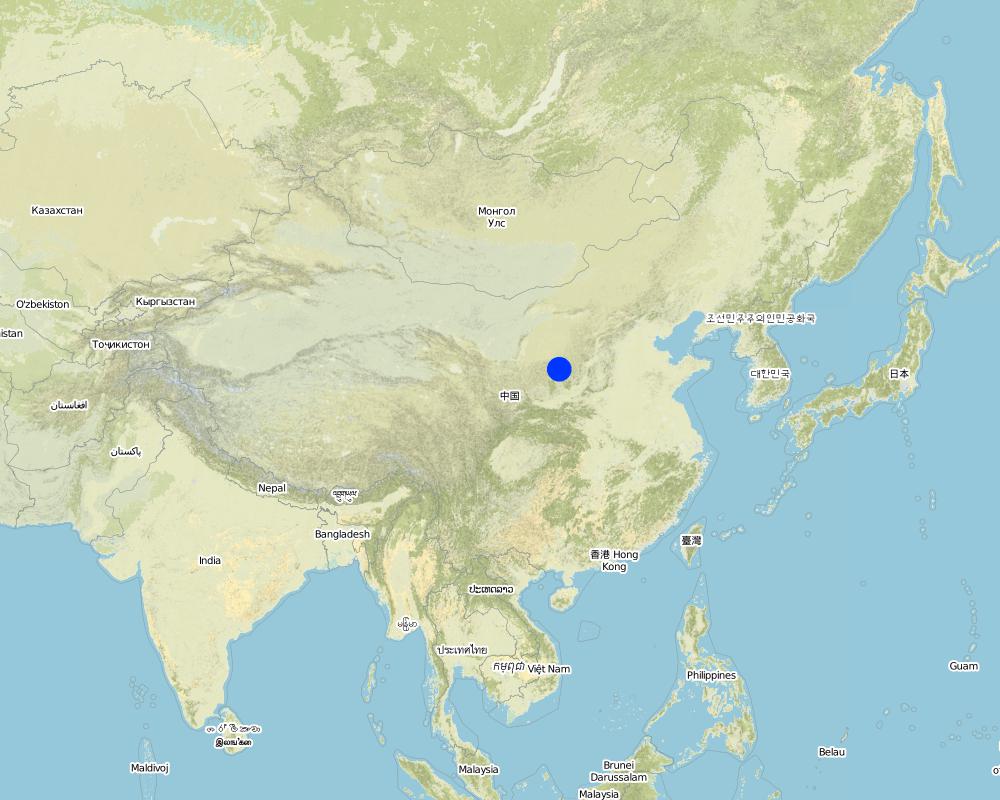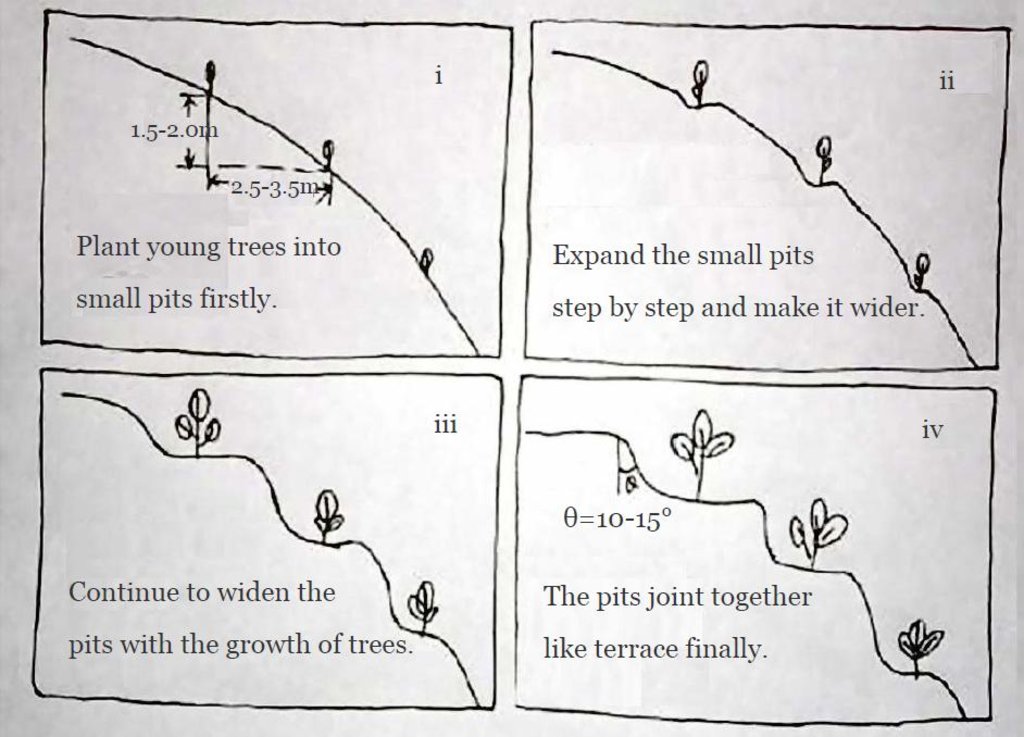Progressive bench terrace [Chine]
- Création :
- Mise à jour :
- Compilateur : Fei WANG
- Rédacteur : –
- Examinateurs : Deborah Niggli, Alexandra Gavilano
树盘,逐年扩盘
technologies_1522 - Chine
Voir les sections
Développer tout Réduire tout1. Informations générales
1.2 Coordonnées des personnes-ressources et des institutions impliquées dans l'évaluation et la documentation de la Technologie
Spécialiste GDT:
Chen Yunming
Institute of Soil and Water Conservation, CAS and MWR
Chine
Spécialiste GDT:
Liu Guobin
Institute of Soil and Water Conservation, CAS and MWR
Chine
Spécialiste GDT:
Cao Qingyu
Chine
Nom du projet qui a facilité la documentation/ l'évaluation de la Technologie (si pertinent)
DESIRE (EU-DES!RE)Nom du ou des institutions qui ont facilité la documentation/ l'évaluation de la Technologie (si pertinent)
Northwest A&F University (NWAFU) - Chine1.3 Conditions relatives à l'utilisation par WOCAT des données documentées
Le compilateur et la(les) personne(s) ressource(s) acceptent les conditions relatives à l'utilisation par WOCAT des données documentées:
Oui
2. Description de la Technologie de GDT
2.1 Courte description de la Technologie
Définition de la Technologie:
Bench terraces are progressively expanded to form a fully developed terrace system in order to reduce runoff and soil erosion on medium- to high- angled loess slopes.
2.2 Description détaillée de la Technologie
Description:
n Miaowan Village, the technology is mainly applied to apple tree plantations. Tree seedlings are planted in rows every 4 m along the contour with a spacing of 2.5-3.5 m between rows. Trees are planted in pits 40 cm diameter and 3040 cm deep. Manure and/or fertilizer are applied and the seedlings are watered.
Around each tree, soil from the upper parts of the slope is removed and deposited below in order to extend the flat terrain. Over 5-10 years, the terraces become enlarged around each tree and form a terrace with the neighbouring trees along the contour, such that the slopes are transformed into level bench terraces. The fruit trees are located in the middle of the terrace. All the work is done manually using shovels.
Purpose of the Technology: The main purpose of this technology is to reduce runoff and soil erosion on the slope and to improve soil quality and soil moisture retention. It is a sustainable land use technology for small farmers because farmers can use their spare time to improve the land’s condition during the growth of the trees.
A major aim is to conserve water and reduce runoff. Soil erosion in this village is very severe and the soil erosion rate before amounted to 60-100 tonnes per hectare per year and was reduced practically to zero as a result of building the terraces. Slope gradients are very steep (around 20-35 degrees). The main income of local farmers is from orchards.
Establishment / maintenance activities and inputs: The establishment phase thus takes 5-10 years. Afterwards maintenance inputs are restricted to repairing the terrace walls.
2.3 Photos de la Technologie
2.5 Pays/ région/ lieux où la Technologie a été appliquée et qui sont couverts par cette évaluation
Pays:
Chine
Région/ Etat/ Province:
Shaanxi
Autres spécifications du lieu:
Miaowan Village, Xuejiagou Watershed
Spécifiez la diffusion de la Technologie:
- répartie uniformément sur une zone
Si la Technologie est uniformément répartie sur une zone, précisez la superficie couverte (en km2):
2,55
Commentaires:
Boundary points of the Technology area: The technology is around the village.
Total area covered by the SLM Technology is 2.55 km2.
The whole area of this watershed is about 7.5 Km^2. There are a lot of orchard, mostly apple, in this watershed. It is one of typical watershed with specially soil erosion problem despite the high plant coverage.
Map
×2.6 Date de mise en œuvre de la Technologie
Si l'année précise est inconnue, indiquez la date approximative: :
- il y a entre 10-50 ans
2.7 Introduction de la Technologie
Spécifiez comment la Technologie a été introduite: :
- grâce à l'innovation d'exploitants des terres
Commentaires (type de projet, etc.) :
It is a kind of traditional method.
3. Classification de la Technologie de GDT
3.1 Principal(aux) objectif(s) de la Technologie
- réduire, prévenir, restaurer les terres dégradées
3.2 Type(s) actuel(s) d'utilisation des terres, là où la Technologie est appliquée
Les divers types d'utilisation des terres au sein du même unité de terrain: :
Oui
Précisez l'utilisation mixte des terres (cultures/ pâturages/ arbres):
- Agroforesterie

Terres cultivées
- Cultures annuelles
- Plantations d’arbres ou de buissons
Cultures annuelles - Précisez les cultures:
- plantes à racines et à tubercules - pommes de terre
Plantations d'arbres et d'arbustes - Précisez les cultures:
- fruits à pépins (pommes, poires, coings, etc.)
Précisez:
Longest growing period in days: 300Longest growing period from month to month: Mar - NovSecond longest growing period in days: 200Second longest growing period from month to month: Apr - Oct
Commentaires:
Major land use problems (compiler’s opinion): On moderate- to high-angled slopes, water loss and soil erosion are very high. Outside the protected canopy of the trees rainsplash impact during heavy storms is very severe. The local farmers clear all the wild grasses and shrubs, such as Korshinsk Peashrub, Artemisia scoparia, Leymus secalinus, Stipa bungeana, Lespedeza davurica etc. to reduce competition with the fruit trees. Consequently, the soil is bare and unprotected
3.4 Approvisionnement en eau
Approvisionnement en eau des terres sur lesquelles est appliquée la Technologie:
- pluvial
3.5 Groupe de GDT auquel appartient la Technologie
- mesures en travers de la pente
3.6 Mesures de GDT constituant la Technologie

structures physiques
- S11: Autres
Commentaires:
Main measures: structural measures
3.7 Principaux types de dégradation des terres traités par la Technologie

érosion hydrique des sols
- Wt: perte de la couche superficielle des sols (couche arable)/ érosion de surface

dégradation hydrique
- Ha: aridification
Commentaires:
Main type of degradation addressed: Wt: loss of topsoil / surface erosion
Secondary types of degradation addressed: Ha: aridification
Main causes of degradation: Heavy / extreme rainfall (intensity/amounts) (Storm are strong in summer.), other natural causes (avalanches, volcanic eruptions, mud flows, highly susceptible natural resources, extreme topography, etc.) specify (orchards on steep slopes without conservation measures), poverty / wealth (to increase the yield and income of orchard.)
Secondary causes of degradation: deforestation / removal of natural vegetation (incl. forest fires) (There is no natural grass cover here.), droughts (Lack of water for the cash trees)
3.8 Prévention, réduction de la dégradation ou réhabilitation des terres dégradées
Spécifiez l'objectif de la Technologie au regard de la dégradation des terres:
- prévenir la dégradation des terres
- réduire la dégradation des terres
Commentaires:
Main goals: prevention of land degradation
Secondary goals: mitigation / reduction of land degradation
4. Spécifications techniques, activités, intrants et coûts de mise en œuvre
4.1 Dessin technique de la Technologie
Spécifications techniques (associées au dessin technique):
i: first year: planting of fruit trees along the contour in small pits
ii: after 3-4 years: a small terrace is built up around each tree (as the tree grows it needs more water, which is collected from the platform around the trees..
iii: after 5-8 years: terraces develop
iv: final stage: fully developed level bench terraces
Owing to the soil properties of loess, there is no need to separate surface and subsoil as there is little difference between them. Therefore, soil can be moved directly from upper to lower parts of the terrace without changing soil fertility.
Location: Miaowan Village, Xuejiagou Watershed. Ansai County, Shaanxi Province, China
Date: 2008-12-20
Technical knowledge required for land users: moderate (It is easy to understand and implement.)
Main technical functions: control of concentrated runoff: retain / trap, reduced soil loss
Secondary technical functions: reduction of slope angle, increase of infiltration
Reshaping surface
Vertical interval between structures (m): 1
Spacing between structures (m): 2.5
Depth of ditches/pits/dams (m): 1..5
Width of ditches/pits/dams (m): 2.5
Length of ditches/pits/dams (m): 100-150
Construction material (earth): Using the earth of the same land.
Slope (which determines the spacing indicated above): 45%
If the original slope has changed as a result of the Technology, the slope today is: 2%
Lateral gradient along the structure: 2%
Auteur:
Wang Fei, Yangling, Shaanxi Province, China
4.2 Informations générales sur le calcul des intrants et des coûts
Indiquez la monnaie utilisée pour le calcul des coûts:
- dollars américains
Indiquez le coût salarial moyen de la main d'œuvre par jour:
14.2
4.3 Activités de mise en place/ d'établissement
| Activité | Calendrier des activités (saisonnier) | |
|---|---|---|
| 1. | Plant the young trees with small pits. | Before practice |
| 2. | The soils from the upper parts of the slope is shovelled away and deposited on the lower side of the trees | |
| 3. | Expand the pits into a large platform year by year. | |
| 4. | 3.4 years after planning the trees a level platform of 2 to 3 square meters around the trees is build. | |
| 5. | The platforms increase and the space between trees is change into terrace. |
4.4 Coûts et intrants nécessaires à la mise en place
| Spécifiez les intrants | Unité | Quantité | Coûts par unité | Coût total par intrant | % des coût supporté par les exploitants des terres | |
|---|---|---|---|---|---|---|
| Main d'œuvre | Planting trees | Person/day | 120,0 | 7,3 | 876,0 | 100,0 |
| Main d'œuvre | Building pits | Person/day | 750,0 | 7,3 | 5475,0 | 100,0 |
| Coût total de mise en place de la Technologie | 6351,0 | |||||
| Coût total de mise en place de la Technologie en dollars américains (USD) | 6351,0 | |||||
Commentaires:
Duration of establishment phase: 60 month(s)
4.5 Activités d'entretien/ récurrentes
| Activité | Calendrier/ fréquence | |
|---|---|---|
| 1. | Repair the bank of year-after-year terraced land | Annual after it formed |
4.6 Coûts et intrants nécessaires aux activités d'entretien/ récurrentes (par an)
| Spécifiez les intrants | Unité | Quantité | Coûts par unité | Coût total par intrant | % des coût supporté par les exploitants des terres | |
|---|---|---|---|---|---|---|
| Main d'œuvre | Reparing of terraced land | Person/day | 15,0 | 14,6 | 219,0 | 100,0 |
| Coût total d'entretien de la Technologie | 219,0 | |||||
| Coût total d'entretien de la Technologie en dollars américains (USD) | 219,0 | |||||
Commentaires:
Machinery/ tools: spade and hoe
The costs are calculated assuming a local wage rate of 14.2 US$/day.
4.7 Facteurs les plus importants affectant les coûts
Décrivez les facteurs les plus importants affectant les coûts :
Slope is the most important factor. The steeper it is, the higher the cost. Labour was not considered as a cost before, but now it is expensive so that some local farmers do not use this technology.
5. Environnement naturel et humain
5.1 Climat
Précipitations annuelles
- < 250 mm
- 251-500 mm
- 501-750 mm
- 751-1000 mm
- 1001-1500 mm
- 1501-2000 mm
- 2001-3000 mm
- 3001-4000 mm
- > 4000 mm
Spécifications/ commentaires sur les précipitations:
The mean annual rainfall in the basin is 515.2 mm in the duration from 1952 to 2000. The rainfall from May to Oct accounts for 446.8 mm, up to 86.7%; and that from Jun to Sep accounts for 367.6 mm
Zone agro-climatique
- semi-aride
Thermal climate class: temperate. The accumulating time that temperature above 0 ℃ about 3800 hours, and that above 10 ℃ is more than 3200 hours
It is based on the classification sysytem only based on the rainfall
5.2 Topographie
Pentes moyennes:
- plat (0-2 %)
- faible (3-5%)
- modéré (6-10%)
- onduleux (11-15%)
- vallonné (16-30%)
- raide (31-60%)
- très raide (>60%)
Reliefs:
- plateaux/ plaines
- crêtes
- flancs/ pentes de montagne
- flancs/ pentes de colline
- piémonts/ glacis (bas de pente)
- fonds de vallée/bas-fonds
Zones altitudinales:
- 0-100 m
- 101-500 m
- 501-1000 m
- 1001-1500 m
- 1501-2000 m
- 2001-2500 m
- 2501-3000 m
- 3001-4000 m
- > 4000 m
Indiquez si la Technologie est spécifiquement appliquée dans des:
- non pertinent
Commentaires et précisions supplémentaires sur la topographie:
Altitudinal zone 501-1,000 m a.s.l.: Most area is in this altitudinal zonation
Landforms: Based on 1:100 thousand scale landform map
Slopes on average: Based on 1:100 thousand scale landform map
5.3 Sols
Profondeur moyenne du sol:
- très superficiel (0-20 cm)
- superficiel (21-50 cm)
- modérément profond (51-80 cm)
- profond (81-120 cm)
- très profond (>120 cm)
Texture du sol (de la couche arable):
- moyen (limoneux)
Matière organique de la couche arable:
- faible (<1%)
Si disponible, joignez une description complète du sol ou précisez les informations disponibles, par ex., type de sol, pH/ acidité du sol, capacité d'échange cationique, azote, salinité, etc.
Soil depth on average: The depth of Loess varies from nearly 30 m to more than 100 m in Yanhe River Basin. The depth of soil is less than this but it could be nearly 10 meters in common
Soil texture (topsoil): Here are more than 50% soil particle are fine sand with size between 0.05 and 0.1 mm
Soil fertility very low: Lack of N, P and SOM
Topsoil organic matter: <0.5%
Soil drainage / infiltration good: The inflitration of Loess is very fast, but it is prone to sealing when flashing.
Soil water storage capacity low: It is easy to evaporation and drainage
5.4 Disponibilité et qualité de l'eau
Profondeur estimée de l’eau dans le sol:
5-50 m
Disponibilité de l’eau de surface:
moyenne
Qualité de l’eau (non traitée):
eau potable
Commentaires et précisions supplémentaires sur la qualité et la quantité d'eau:
Availability of surface also poor/ none: Nearly all the branches of Yanhe are seasonal river
Availability of surface water medium: It is very stable in this region
Water quality (untreated): Good quality for there are few pollution sources
5.5 Biodiversité
Diversité des espèces:
- moyenne
Commentaires et précisions supplémentaires sur la biodiversité:
It is very stable in this region
5.6 Caractéristiques des exploitants des terres appliquant la Technologie
Orientation du système de production:
- commercial/ de marché
Revenus hors exploitation:
- 10-50% de tous les revenus
Niveau relatif de richesse:
- riche
Individus ou groupes:
- individu/ ménage
Niveau de mécanisation:
- travail manuel
Genre:
- femmes
- hommes
Indiquez toute autre caractéristique pertinente des exploitants des terres:
Land users applying the Technology are mainly common / average land users
Difference in the involvement of women and men: No clear difference.
Population density: 50-100 persons/km2
Annual population growth: < 0.5%
30% of the land users are rich and own 30% of the land (Higher yield and income.).
Off-farm income specification: Only a few land users have implemented this measure because there are other market based activities that bring higher returns. Sometimes farmers have enough money to buy more fertilizer for the orchard.
Level of mechanization: nearly all the work is done by hand.
Market orientation of production system: It is on apple production base and this generates good income of local farmers
5.7 Superficie moyenne des terres utilisées par les exploitants des terres appliquant la Technologie
- < 0,5 ha
- 0,5-1 ha
- 1-2 ha
- 2-5 ha
- 5-15 ha
- 15-50 ha
- 50-100 ha
- 100-500 ha
- 500-1 000 ha
- 1 000-10 000 ha
- > 10 000 ha
Cette superficie est-elle considérée comme de petite, moyenne ou grande dimension (en se référant au contexte local)?
- petite dimension
Commentaires:
0.054 ha per capita
5.8 Propriété foncière, droits d’utilisation des terres et de l'eau
Propriété foncière:
- état
- communauté/ village
Droits d’utilisation des terres:
- individuel
Droits d’utilisation de l’eau:
- accès libre (non organisé)
5.9 Accès aux services et aux infrastructures
santé:
- pauvre
- modéré
- bonne
éducation:
- pauvre
- modéré
- bonne
emploi (par ex. hors exploitation):
- pauvre
- modéré
- bonne
routes et transports:
- pauvre
- modéré
- bonne
eau potable et assainissement:
- pauvre
- modéré
- bonne
services financiers:
- pauvre
- modéré
- bonne
6. Impacts et conclusions
6.1 Impacts sur site que la Technologie a montrés
Impacts socio-économiques
Production
production agricole
Quantité avant la GDT:
45000kg
Quantité après la GDT:
52500kg
Commentaires/ spécifiez:
Yield increasing by 16.7%
Revenus et coûts
revenus agricoles
Quantité avant la GDT:
9883
Quantité après la GDT:
11530
Commentaires/ spécifiez:
Income increases by 1647 USD per ha.
charge de travail
Quantité avant la GDT:
1500
Quantité après la GDT:
1650
Commentaires/ spécifiez:
10% person days increases annually in the first 5 years
Impacts socioculturels
situation des groupes socialement et économiquement désavantagés
Quantité avant la GDT:
2700
Quantité après la GDT:
3200
Commentaires/ spécifiez:
Not excluding of the labour input of the local farmers themselves.
Livelihoods and human well-being
Impacts écologiques
Cycle de l'eau/ ruissellement
ruissellement de surface
Quantité avant la GDT:
60 mm/yr
Quantité après la GDT:
<10 mm/yr
Commentaires/ spécifiez:
no runoff in common
Sols
perte en sol
Quantité avant la GDT:
60 t/yr/ha
Quantité après la GDT:
10 t/yr/ha
Commentaires/ spécifiez:
Soil erosion is well controlled
6.2 Impacts hors site que la Technologie a montrés
flux des cours d'eau fiables et stables en saison sèche
Quantité avant la GDT:
60mm/yr
Quantité après la GDT:
<10mm/yr
inondations en aval
Quantité avant la GDT:
60 mm/yr
Quantité après la GDT:
<10 mm/yr
6.3 Exposition et sensibilité de la Technologie aux changements progressifs et aux évènements extrêmes/catastrophes liés au climat (telles que perçues par les exploitants des terres)
Changements climatiques progressifs
Changements climatiques progressifs
| Saison | Augmentation ou diminution | Comment la Technologie fait-elle face à cela? | |
|---|---|---|---|
| températures annuelles | augmente | bien |
Extrêmes climatiques (catastrophes)
Catastrophes météorologiques
| Comment la Technologie fait-elle face à cela? | |
|---|---|
| pluie torrentielle locale | bien |
| tempête de vent locale | pas bien |
Catastrophes climatiques
| Comment la Technologie fait-elle face à cela? | |
|---|---|
| sécheresse | bien |
Catastrophes hydrologiques
| Comment la Technologie fait-elle face à cela? | |
|---|---|
| inondation générale (rivière) | pas connu |
Autres conséquences liées au climat
Autres conséquences liées au climat
| Comment la Technologie fait-elle face à cela? | |
|---|---|
| réduction de la période de croissance | pas connu |
Commentaires:
The technology increases infiltration, reduces soil erosion by water and improves soil moisture retention to reduce the negative impact of extreme drought. However, it does not protect the soil well from wind erosion. Soil cover could be increased to protect against strong winds and reduce
6.4 Analyse coûts-bénéfices
Quels sont les bénéfices comparativement aux coûts de mise en place (du point de vue des exploitants des terres)?
Rentabilité à court terme:
légèrement positive
Rentabilité à long terme:
positive
Quels sont les bénéfices comparativement aux coûts d'entretien récurrents (du point de vue des exploitants des terres)?
Rentabilité à court terme:
positive
Rentabilité à long terme:
positive
Commentaires:
It is very cheap to maintain this measure. More trees could be planted on degraded land in future.
6.5 Adoption de la Technologie
- 11-50%
Si disponible, quantifiez (nombre de ménages et/ou superficie couverte):
65 households (15percent of the stated area)
De tous ceux qui ont adopté la Technologie, combien d'entre eux l'ont fait spontanément, à savoir sans recevoir aucune incitation matérielle, ou aucune rémunération? :
- 91-100%
Commentaires:
Comments on acceptance with external material support: There are no outside input to do sunch thing.
100% of land user families have adopted the Technology without any external material support
65 land user families have adopted the Technology without any external material support
Comments on spontaneous adoption: In this area, there are many other practices, such as reforestation, enclosure (to prevent grazing) and terrace construction.
There is a moderate trend towards spontaneous adoption of the Technology
Comments on adoption trend: Even the local farmers know the benefits of progressive bench terraces, but with the increased labour costs, fewer people apply this technology.
6.7 Points forts/ avantages/ possibilités de la Technologie
| Points forts/ avantages/ possibilités du point de vue de l'exploitant des terres |
|---|
|
Higher yield and income. How can they be sustained / enhanced? If they have time, they wish to adopt this technology. |
| Points forts/ avantages/ possibilités du point de vue du compilateur ou d'une autre personne ressource clé |
|---|
|
Establishing the technology over a long time. Local farmers have enough time to do it How can they be sustained / enhanced? Show to land users that they have time and can spread to work over many years and fit the labour into the time they have available. |
|
It can reduce water loss and soil erosion and prevent the degradation of land How can they be sustained / enhanced? Give subsidy to the local farmers to reduce the sediment delivery into the downstream river. |
|
It can increase soil moisture. How can they be sustained / enhanced? Makes people understand the importance of conserving water with such a technology. |
|
Higher yield and income. How can they be sustained / enhanced? Share ideas through meeting in the field. Present this measure to more people and show them how to apply it and promote the technology to more farmers. |
6.8 Faiblesses/ inconvénients/ risques de la Technologie et moyens de les surmonter
| Faiblesses/ inconvénients/ risques du point de vue de l’exploitant des terres | Comment peuvent-ils être surmontés? |
|---|---|
| It takes a lot of time to establish it. | It is difficult to use it, because the people could balance the establishment costs and work at the labour market. If they can get some subsidy from government, they may adapt this measure. |
| Faiblesses/ inconvénients/ risques du point de vue du compilateur ou d'une autre personne ressource clé | Comment peuvent-ils être surmontés? |
|---|---|
| It takes considerable time to establish and labour is more and more expensive so that farmers are looking for paid work | Subsidy for farmers using this measure. |
7. Références et liens
7.1 Méthodes/ sources d'information
7.2 Références des publications disponibles
Titre, auteur, année, ISBN:
Soil and water conservation records of Shaanxi Province. 2000. Shaanxi People's Press, Xi'an City, China
Disponible à partir d'où? Coût?
Library of ISWC, CAS
Liens et modules
Développer tout Réduire toutLiens
Aucun lien
Modules
Aucun module trouvé


